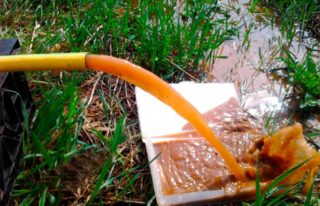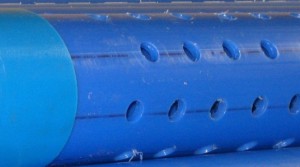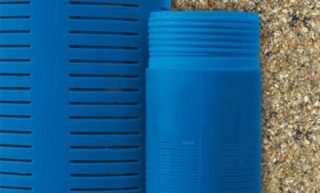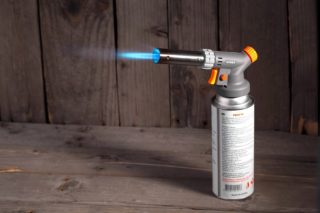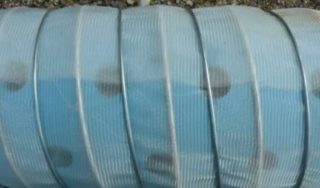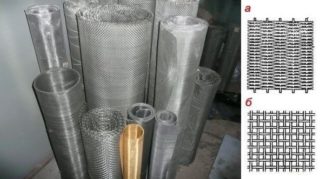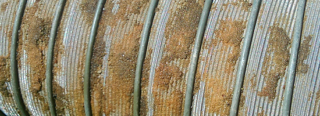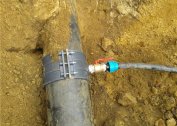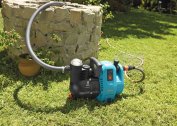If an autonomous water supply system is built in the infield, water is most often taken from a well or well, the quality of the water in which depends on the depth and composition of the aquifer. If we are not talking about artesian wells, but about sand ones, then they must be equipped with cleaning filters at the bottom of the casing.
How to choose the right filter
Before you make a downhole filter yourself, you need to familiarize yourself with the varieties and purpose of the cleaning elements. Well liquid is cleaned in two stages - a filter in the well and a surface one, which is cut into the water main. The device consists of three main parts:
- Sump - a cavity designed for the accumulation of solid particles of sand, silt and soil. The approximate length of the tank is 0.5 meters.
- The filter elements consist of numerous holes in the pipe of small sizes, as well as external materials that are attached to it.
- Superfilter section - a part that plays the role of fittings when installed on the source casing.
To choose the right filter, you need to understand what requirements it must meet. Well water rises to the surface, overcoming the layers of soil and other low-flowing rocks, as a result of which its composition is enriched with extraneous impurities, which do not always favorably affect the performance of expensive equipment and human health. To prevent unpleasant phenomena, it is necessary to understand what type of filters there are filters and which is preferable to install.
- A perforated device equipped with a net is the most popular variety. This is a polypropylene or metal pipe with a large number of orderly arranged through holes. Making a do-it-yourself filter for a well from a plastic or metal pipe is simple, but the design has one significant drawback - low productivity due to the large flow of water.
- The slot design has high throughput, which makes the system productive and efficient. Design features are similar to the previous variety, except that cuts are used instead of holes. Water penetrates through the notches located on the pipe, and solid particles and other impurities settle on the walls. Thickness is determined based on the concentration and size of solid particles in well water. A mesh slit filter is the most preferred form for clay-sand aquifers.
- The gravel filter is one of the most cost-effective and easiest to implement designs. It is a pillow consisting of fine gravel. They are used, as a rule, together with a strainer on sandy or calcareous sources of shallow depth.
- The filtering design with a wire winding is an upgraded version of the strainer. Instead of a mesh, the pipe is wrapped with a special wedge-shaped wire made of stainless steel.
You can make all of these types of filters with your own hands, the costs are usually small.
Necessary tools and materials
Before starting work, you need to prepare all the necessary working equipment and supplies. To make a cleaning structure, you will need:
- drill;
- electric drill;
- drills to it with a diameter of 1-1.5 cm;
- gas cutter;
- milling cutter;
- welding;
- roulette;
- stapler.
The list of materials will depend on the type of construction chosen.
How to make a filter for a well on the sand with your own hands
For the primary purification of well water, holey or slotted types of filters are most often installed. The advantages are efficiency and ease of manufacture. The technology is as follows:
- Prepare a plastic or metal pipe of the appropriate diameter. It should be less than the diameter of the casing, the length depends on the depth of the aquifer. It is also important to purchase a mesh made of stainless steel or brass with small cells.
- On the prepared pipe, a section of at least 10 cm in length is marked. It will be intended for the sump.
- A little higher is the marking for the hole part. The holes are staggered, the distance between them should be at least 1-3 cm. The more holes, the higher the throughput of the structure.
- Using a drill, holes are made from the bottom up at an angle of no more than 60 degrees.
- All garbage at the end of work is removed, the pipe is fitted with a perforated mesh. Its location is fixed using rivets.
- From the side where the sump is located, the pipe is closed with a plug.
The area of the holes should occupy at least a quarter of the total area of the filter.
Recommendations for the manufacture of wire, gravel and strainer
For high performance of sewage treatment plants, it is required to choose the right size of cells on the grid or holes on plastic, metal pipes. This will require solid particles from well water to be sifted through the possible mesh options. Preference should be given to the grid that retained more than 50% of the impurities.
Before you install the grid, it is important to make the case by winding steel wire at intervals of 2-3 cm. The structure is fixed using a soldering iron or a special adhesive. The latter option is used for fabric and plastic products.
If you need to build a gravel pillow, it is important to choose the right fraction - the size of the treatment pad. It should be several times larger than the size of mechanical debris. Instead of gravel, river pebbles can also be used.
Common mistakes
Creating a do-it-yourself cleaning structure is painstaking work that takes a lot of time and effort. It is possible that people without experience will make mistakes in the process of creating the system. To avoid them, you should familiarize yourself with the main mistakes that people inexperienced in these matters make:
- Cut holes are excessively small. This adversely affects the throughput of the structure. Holes quickly become clogged with solid impurities, as a result, the filter ceases to function.
- Incorrect pipe diameter measurement. At this stage of manufacturing, special vigilance must be shown, otherwise the pipe may simply not enter the casing.
In reality, more errors are allowed, the most common are indicated. It is almost impossible to fix them, more often you have to re-purchase new consumables.
